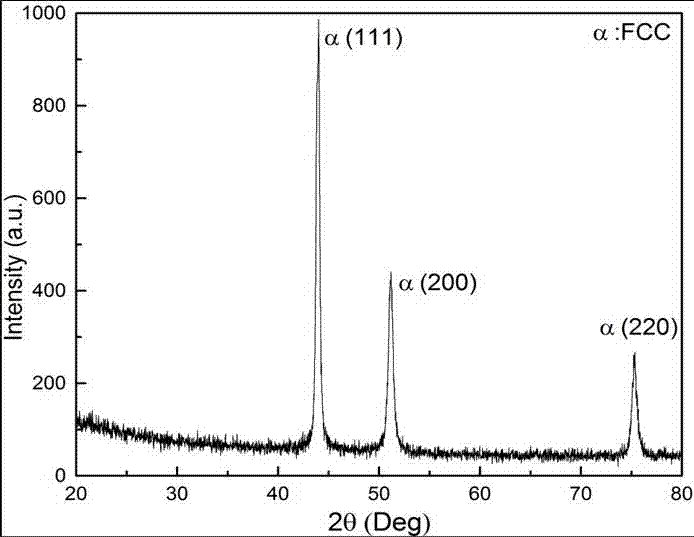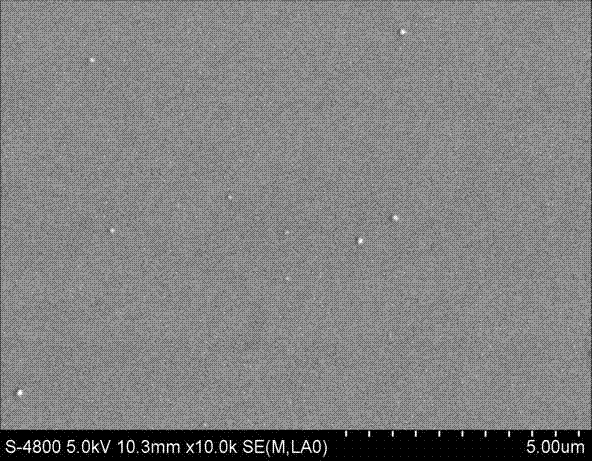Zirconium cladding surface resistant to high temperature and oxidation ZrCrFe/AlCrFeTiZr composite gradient coating preparing technology
A technology of high temperature oxidation resistance and preparation technology, which is applied in the direction of metal material coating technology, coating, ion implantation plating, etc., can solve problems such as explosion and inability to ensure structural integrity, achieve high strength and hardness, and improve high temperature resistance Oxidation performance, effect of releasing internal stress
- Summary
- Abstract
- Description
- Claims
- Application Information
AI Technical Summary
Problems solved by technology
Method used
Image
Examples
Embodiment 1
[0023] a. Clean the substrate material: Use water sandpaper with different roughness to zirconium alloy (Zr 4 alloy) substrate for grinding and polishing; then use acetone and ethanol as solvents to degrease and degrease and clean in an ultrasonic instrument; then clean with deionized water, dry and put into a vacuum chamber, the vacuum degree is -4 Pa;
[0024] b. Treatment of the substrate before deposition: keep the vacuum chamber vacuum -4 Under the condition of Pa, the reverse sputtering was used for 10 minutes to clean the zirconium alloy substrate; the reverse sputtering bias voltage was -500 V; the reverse sputtering gas was Ar; the reverse sputtering pressure in the vacuum chamber was 3.0 Pa;
[0025] c. Pre-sputtering: Keep the vacuum chamber vacuum -4 Under the condition of Pa, pre-sputtering was used to clean each target for 15 minutes to remove impurities on the target surface; the pre-sputtering power was 110 W; the pre-sputtering bias was -110 V; the pre-sput...
Embodiment 2
[0029] a. Clean the substrate material: Use water sandpaper with different roughness to zirconium alloy (Zr 4 alloy) substrate for grinding and polishing; then use acetone and ethanol as solvents to degrease and degrease and clean in an ultrasonic instrument; then clean with deionized water, dry and put into a vacuum chamber, the vacuum degree is -4 Pa;
[0030] b. Treatment of the substrate before deposition: keep the vacuum chamber vacuum -4 Under the condition of Pa, the reverse sputtering was used for 10 minutes to clean the zirconium alloy substrate; the reverse sputtering bias voltage was -500 V; the reverse sputtering gas was Ar; the reverse sputtering pressure in the vacuum chamber was 3.0 Pa;
[0031] c. Pre-sputtering: Keep the vacuum chamber vacuum -4 Under the condition of Pa, pre-sputtering was used to clean each target for 15 minutes to remove impurities on the target surface; the pre-sputtering power was 110 W; the pre-sputtering bias was -110 V; the pre-sput...
Embodiment 3
[0034] a. Clean the substrate material: Use water sandpaper with different roughness to zirconium alloy (Zr 4 alloy) substrate for grinding and polishing; then use acetone and ethanol as solvents to degrease and degrease and clean in an ultrasonic instrument; then clean with deionized water, dry and put into a vacuum chamber, the vacuum degree is -4 Pa;
[0035] b. Treatment of the substrate before deposition: keep the vacuum chamber vacuum -4 Under the condition of Pa, the reverse sputtering was used for 10 minutes to clean the zirconium alloy substrate; the reverse sputtering bias voltage was -500 V; the reverse sputtering gas was Ar; the reverse sputtering pressure in the vacuum chamber was 3.0 Pa;
[0036] c. Pre-sputtering: Keep the vacuum chamber vacuum -4 Under the condition of Pa, pre-sputtering was used to clean each target for 15 minutes to remove impurities on the target surface; the pre-sputtering power was 110 W; the pre-sputtering bias was -110 V; the pre-sput...
PUM
 Login to View More
Login to View More Abstract
Description
Claims
Application Information
 Login to View More
Login to View More - R&D
- Intellectual Property
- Life Sciences
- Materials
- Tech Scout
- Unparalleled Data Quality
- Higher Quality Content
- 60% Fewer Hallucinations
Browse by: Latest US Patents, China's latest patents, Technical Efficacy Thesaurus, Application Domain, Technology Topic, Popular Technical Reports.
© 2025 PatSnap. All rights reserved.Legal|Privacy policy|Modern Slavery Act Transparency Statement|Sitemap|About US| Contact US: help@patsnap.com


